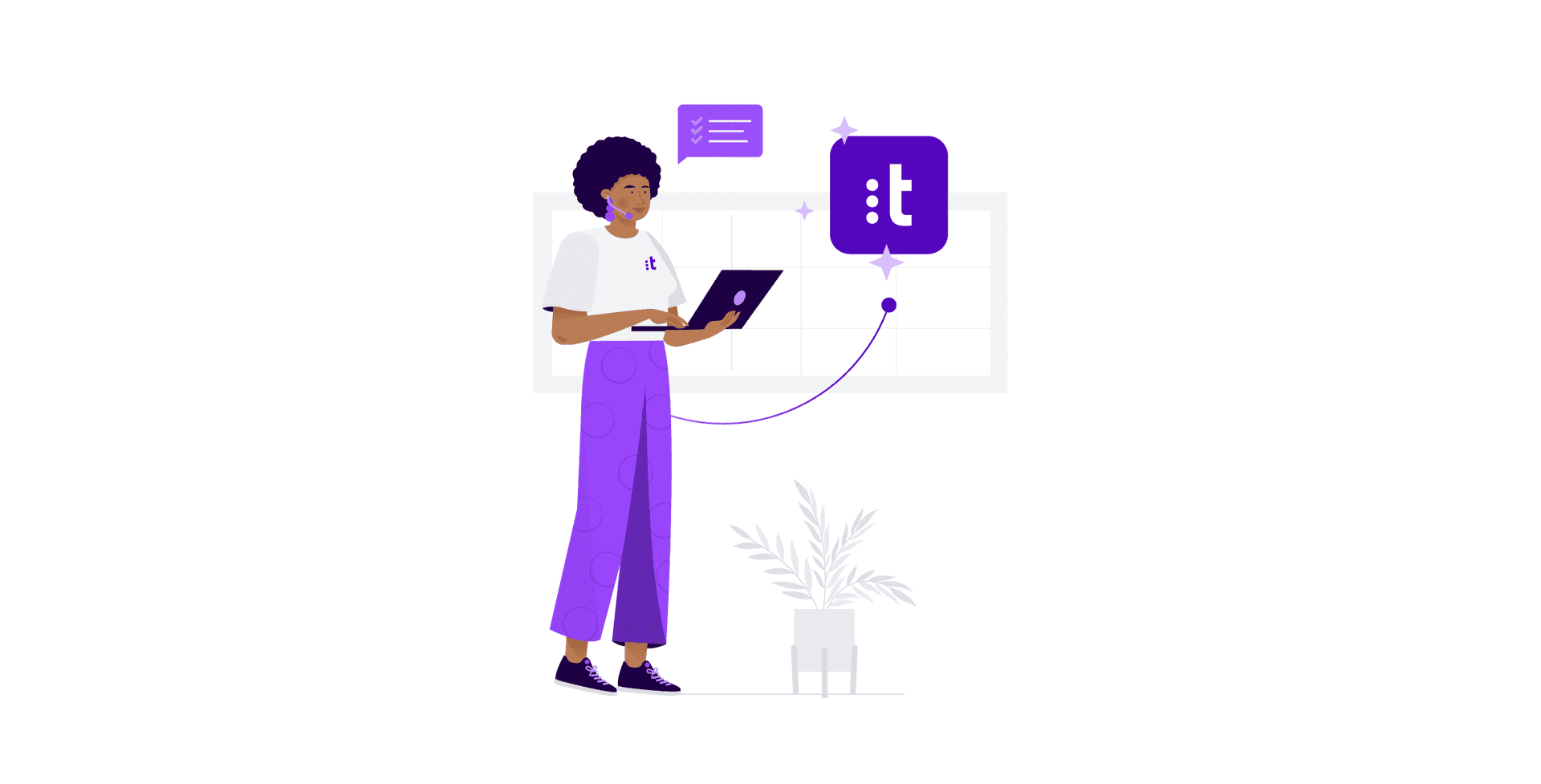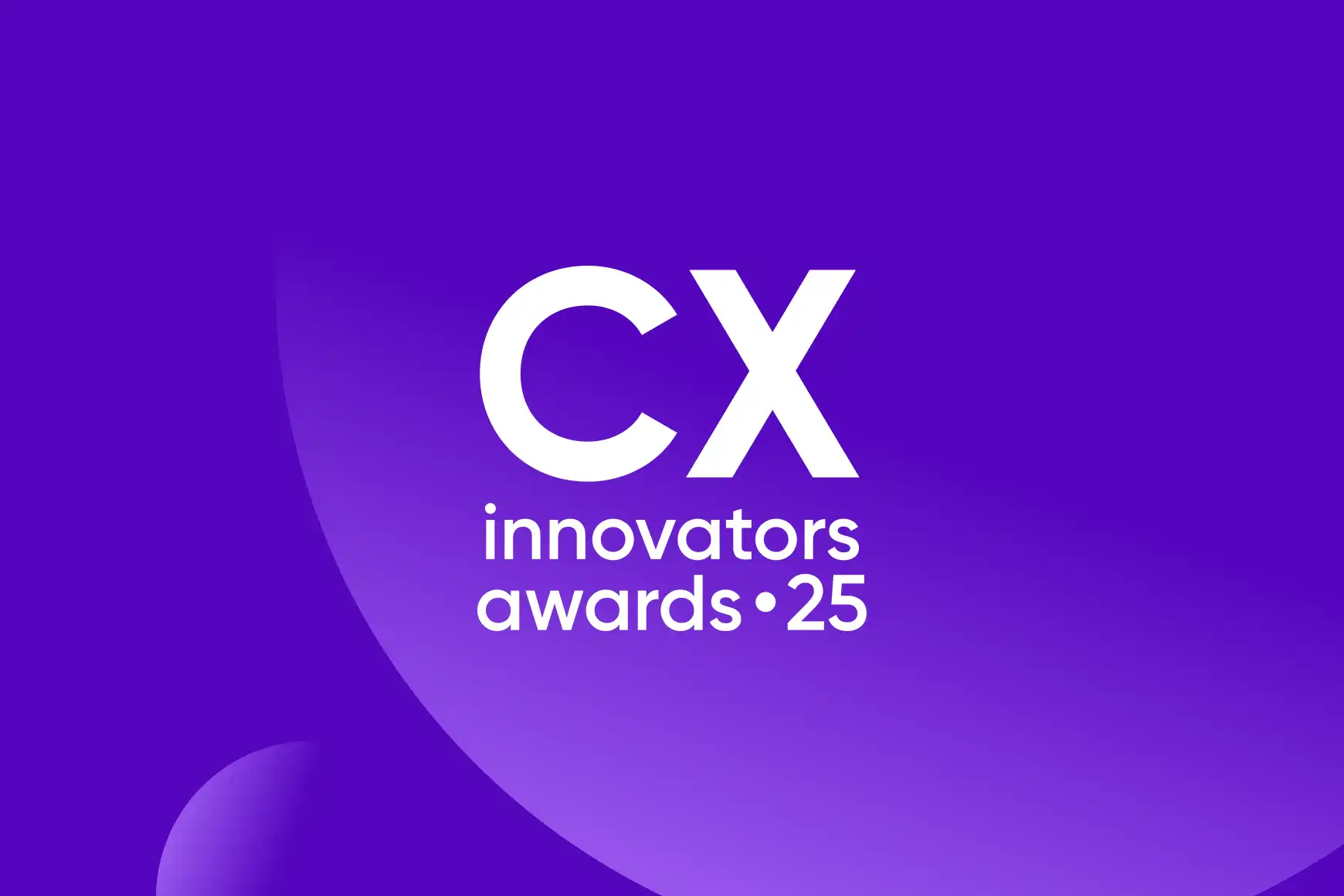Contact center acronyms and definitions: The ultimate list

By Celia Cerdeira
0 min read

Navigating contact center terms is tricky, particularly when it comes to all the acronyms and abbreviations used. Whether your job involves complex technical support or simply providing product updates, knowing customer service acronyms and call center abbreviations is essential.
Let’s dive in and explore commonly used contact center jargon, from cloud contact center software to workforce optimization. Consider this your go-to source to decode the language of call centers.
A closer look at customer service acronyms.
The customer service acronyms are listed alphabetically in English.
A – Call center acronyms and terms starting with A.
Abandonment rate
Call center abandonment rate is a call center metric that records the percentage of calls terminated by callers after being placed in a queue (after going through an IVR and before ringing an agent or ring group).
After call work (ACW)
After call work (ACW) is the average amount of time an agent takes to wrap up a call.
Application program interface (API)
An application program interface (API) is a software intermediary that allows two applications to talk to each other. In the contact center environment, they are often used to provide agents with information from several different databases in one application.
Application service provider (ASP)
An application service provider (ASP) is a company that provides software applications to customers over the Internet, otherwise known as software as a service (SaaS).
Artificial intelligence (AI)
Artificial intelligence in the contact center uses AI technology, such as machine learning and generative AI, to mimic human intelligence to improve performance and reduce costs.
Artificial general intelligence (AGI)
Artificial intelligence that has the ability to understand, learn, and apply knowledge to perform tasks as a human being.
Automatic call distributor (ACD)
Automatic call distributor (ACD) is a telephony software system that answers incoming calls and routes them to a specific agent or department within a company.
Automatic number identification (ANI)
Automatic number identification (ANI) is a telephony software system that allows the receiver of a phone call to capture and display the phone number of the phone that originated the call.
Automatic speech recognition (ASR)
Automatic speech recognition (ASR) is the technology that allows human beings to use their voices to speak with a computer interface in a conversational way.
Average handle time (AHT)
Average handle time (AHT) is a metric for the average length of customer interaction in the call center. It’s one of the most commonly analyzed KPIs in the call center industry and is frequently assessed when measuring efficiency.
Interested in learning more?
Connect with our team to see how Talkdesk can level-up your Call Center Software Solutions.
Average hold time
Average hold time is the measure of time customers were put on hold during a call with an agent. Agents usually put calls on hold to find additional information or to transfer the call to a more suitable agent.
Average speed of answer (ASA)
Average speed of answer (ASA) is the average number of seconds it takes for a call to be answered.
Average talk time (ATT)
Average talk time (ATT) is the amount of time an agent spends talking with customers.
Average time of abandonment (ATA)
Average time of abandonment (ATA) is the average length of time that a caller will stay in a queue before they hang up the call.
Average wait time
Also known as the average speed of answer, is the average time an inbound call spends waiting in the queue or waiting for a callback.
B – Call center acronyms and terms starting with B.
Back-office management
The back-office typically supports and works to deliver on the objectives and promises of the customer-facing team. It includes the administration of a company’s human resources, technology, and services.
Best-in-class (BIC)
Best-in-class (BIC) is something that has been designated by management as the preferred solution, standard, etc.
Business continuity/disaster recovery (BC/DR)
Business continuity and disaster recovery (BC/DR) are plans and practices put into place that support an organization’s ability to stay operational after an adverse event.
Business continuity planning (BCP)
Business continuity planning (BCP) is planning for all possible scenarios to ensure your call center can continue in the midst of an unexpected issue or event.
Business intelligence (BI)
Business intelligence (BI) is a combination of analytics, data mining, data visualization, data tools, and infrastructure to help call centers make more data-driven decisions and improve agent efficiency and customer experience.
Business process outsourcing (BPO)
Business process outsourcing (BPO) is outsourcing some aspect of your business’s operations to a third-party vendor or service provider.
C – Call center acronyms and terms starting with C.
Call abandonment rate
Call abandonment rate is the percentage of inbound calls that is abandoned by the customer before speaking to an agent. It is calculated as abandoned calls divided by total inbound calls.
Callback
Callback is a feature that allows a customer to instruct the system to return their call later when all agents are unavailable.
Call center management
The term call center management refers to how businesses manage daily call center operations.
Call detail record (CDR)
Call detail record (CDR) is a data record that documents the details of a telephone call or other telecommunications transaction, including caller name and numbers, date and time the call was made, duration, and other information elements.
Caller entered digits (CED)
Caller entered digits (CED) are any digits callers enter using their telephone keypads.
Calling line identity (CLI)
Calling line identity (CLI) is essentially caller ID. It allows the person receiving the call to see the caller’s number.
Call management system (CMS)
A call management system (CMS) is a software product for organizations that receive a large volume of telephone calls. Features often include collecting call-traffic data, creating management reports, and providing an administrative interface.
Chatbot
A chatbot is a software application that is capable of conducting a human-like online chat conversation experience via text or text-to-speech.
ChatGPT
ChatGPT is an artificial intelligence language model developed by OpenAI, designed to generate human-like text based on the input it receives, often used for conversational purposes.
Cloud contact center
A cloud or cloud-based contact center is one that has its technology hosted in the cloud by a third-party vendor.
Contact Center as a Service (CCaaS)
CCaaS stands for contact center as a service, a framework for contact center infrastructure management in the cloud.
Computer telephony integration (CTI)
Computer telephony integration (CTI) is used by call centers handling a large number of incoming calls. CTI uses computers to manage all telephone calls allowing for increased efficiency and better results.
Customer controlled routing (CCR)
Customer controlled routing (CCR) is the process of customizing customer experience by routing incoming calls to specific agents trained to address the customer’s specific issue.
Customer experience (CX)
Customer experience (CX) is the overall perception and emotional response a customer has toward a company based on their interactions and experiences with the company’s products, services, and employees.
Customer Experience Automation (CXA)
Customer Experience Automation (CXA) is a platform designed to automate the full complexity of modern customer journeys. CXA replaces fragmented, manual workflows with coordinated AI agents that scale service, reduce costs, and deliver better outcomes across the enterprise.
Customer experience management (CEM)
Customer experience management (CEM) is the practice of designing and reacting to customer interactions to meet or exceed their expectations, leading to greater customer satisfaction, loyalty, and advocacy.
Customer information system (CIS)
A customer information system (CIS) is a system containing all data pertaining to all customer premises, including addresses, billing determinants, and historical data.
Customer journey
A customer journey is the overall experience a customer has with a company, from awareness to loyalty.
Customer relationship management (CRM)
Customer relationship management (CRM) is all techniques, tools, and technologies used by organizations for developing, retaining, and acquiring customers.
Customer satisfaction (CSAT)
Customer satisfaction (CSAT) is a score that indicates how satisfied a customer is with a specific product, transaction, or interaction with a company. The term CSAT is most often used in the context of a CSAT score, which describes a numerical measure of customer satisfaction.
Customer sentiment
Customer sentiment is a KPI that shows customers’ emotions toward a product, service, or brand. When customers engage with a brand—by using a product and leaving a review online, interacting through phone calls and voice and chatbots, talking about a company on social media, or others—there’s always a predominant emotion involved called sentiment.
Customer service
The support a company gives to its customers before, during, and after they buy a product or service.
Customer service agent (CSA)
A customer service agent (CSA) is a professional who interacts with customers on behalf of a company, providing information, resolving issues, and ensuring a high level of customer satisfaction.
Customer service representative (CSR)
A customer service representative (CSR) is anyone who interacts with customers. They handle complaints, process orders, and provide information about an organization’s products and services.
D – Call center acronyms and terms starting with D.
Dashboard
A call center dashboard is a type of graphical user interface that often provides a simplified visual analysis of relevant KPIs to monitor and optimize performance.
Deep learning (DL)
A subset of machine learning that uses neural networks with many layers (deep neural networks) to analyze various factors and parameters in large amounts of data in order to learn and make accurate decisions.
Deep learning techniques (DLT)
The methodologies and approaches used in deep learning, such as convolutional neural networks (CNNs), recurrent neural networks (RNNs), and long short-term memory (LSTM), to train and optimize deep neural networks.
Dialed number identification service (DNIS)
Dialed number identification service (DNIS) identifies the originally dialed telephone number of an inbound call.
Dialer
An application that automates outbound calls by automatically calling for a number and then delivering the call to an agent. It can be a preview, a predictive, or a power dialer.
Direct inward dialing (DID)
Direct inward dialing (DID) is a telephone service that allows a phone number to ring directly to a specific phone within the organization instead of going to a menu or a queue and needing to dial an extension.
Digital subscriber line (DSL)
Digital subscriber line (DSL) uses existing telephone lines to transport high-bandwidth data, such as multimedia and video, to service subscribers.
Document management system (DMS)
A document management system (DMS) tracks, manages, and stores documents electronically, reducing paper usage and enhancing the organization and retrieval of documents.
Dollars per call (DPC)
Dollars per call (DPC) is a metric used in call centers to measure the average revenue generated per inbound or outbound call.
E – Call center acronyms and terms starting with E.
Email response management system (ERMS)
An email response management system (ERMS) is a set of programs that automatically handles email messages and attachments according to user-defined rules.
Employee engagement
The extent to which employees are actively engaged in their work, directly correlated with employees’ motivation, retention, performance, and customer experience.
Employee satisfaction (ESAT)
A metric that measures how happy employees are with their jobs, work environment, and the overall company culture.
Enterprise application integration (EAI)
Enterprise application integration (EAI) is the use of software and computer systems architectural principles to integrate a set of enterprise computer applications.
Enterprise resource planning (ERP)
Enterprise resource planning (ERP) is the integrated management of call center business processes, often in real-time and mediated by software and technology.
Expected wait time (EWT)
Expected wait time (EWT) is the predicted amount of time an interaction has to wait in a queue before being answered.
F – Call center acronyms and terms starting with F.
First call resolution (FCR)
First call resolution (FCR), also known as first contact resolution, is resolving a customer problem, question or need the first time they call, with no follow-up required.
First call resolution rate (FCRR)
First call resolution rate (FCRR) is a popular call center metric that measures the percentage of calls where the customer’s problem, question, or need was resolved the first time they called.
Forecasting
For the contact center, forecasting is estimating future contact volume (either calls or any other kind of contact) and the number of agents needed to handle that volume.
Full-time equivalent (FTE)
Full-time equivalent (FTE) is equal to the number of total scheduled person-hours divided by the number of hours per week that constitute a full-time person. For example, FTE may consist of several part-time individuals whose combined work hours in a week equal the full-time person. It’s frequently used to forecast staffing needs.
G – Call center acronyms and terms starting with G.
Generative pre-trained transformer (GPT)
GPT is an artificial intelligence model that uses machine learning to generate human-like text enabling it to handle language related tasks like text generation, translation, answer questions, and more.
Grade of service (GOS)
Grade of service (GOS) is a metric that measures the percentage of calls or customer interactions answered within a given time period. It’s typically used to help call centers determine the amount of staff they need to provide an exceptional level of service.
I – Call center acronyms and terms starting with I.
Inbound call
An inbound call is a contact with your business that is initiated by customers or prospects—typically seeking customer service, support, billing, product, or order assistance.
Intelligent network service (INS)
Intelligent network service (INS) helps to distribute calls to multiple destinations present in a virtual contact center network.
Integrated services digital network (ISDN)
An integrated services digital network (ISDN) is a circuit-switched telephone network system that provides access to packet-switched networks and allows digital transmission of voice and data.
Interactive voice response (IVR)
Interactive voice response (IVR) is a telephony menu system that enables the dial pad for identification, segmentation, and routing of callers to the most appropriate agent within your team.
Interexchange carrier (IXC)
Interexchange carrier (IXC) is a legal term for a telecommunication company. It is defined as any carrier that provides services across multiple local access and transport areas.
Internet service provider (ISP)
Internet service provider (ISP) is the industry term for a company that is able to provide you with access to the Internet.
K – Call center acronyms and terms starting with K.
Key performance indicator (KPI)
A key performance indicator (KPI) is a measurable value that demonstrates how effectively a contact center is achieving key business objectives.
Knowledge base
A knowledge base is a published collection of documentation that typically includes answers to frequently asked questions, how-to guides, and troubleshooting instructions.
Knowledge management
Knowledge management is the process of creating, sharing, using, and managing the knowledge and information of an organization.
L – Call center acronyms and terms starting with L.
Large language lodels (LLM)
Large language models (LLMs) are a class of artificial intelligence models that understand and generate human language. They can perform a wide range of natural language processing tasks, such as generating text, summarization, answering questions, sentiment analysis, and more.
Least occupied agent (LOA)
The least occupied agent (LOA) is the agent with the lowest occupancy rate, which is the ratio between the time the agent has been busy compared to the agent’s total time available.
Lifetime customer value (LCV)
Lifetime customer value (LCV) represents the value of a customer over their lifetime as a client of an organization or brand.
Local area network (LAN)
A local area network (LAN) is a computer network that interconnects computers within a limited area such as a residence, school, laboratory, university campus or office building.
M – Call center acronyms and terms starting with M.
Machine Learning (ML)
A form of artificial intelligence that uses algorithms to parse data, learn from it, and make informed decisions or predictions based on what it has learned.
Most idle agent (MIA)
The most idle agent (MIA) is a call center agent who is available and ready to take calls.
Multi-agent orchestration
Multi-agent orchestration is a foundational component of the Talkdesk Customer Experience Automation (CXA) platform, designed to manage and scale complex, end-to-end customer experience automation by coordinating specialized AI agents. These agents are part of a well-trained team, each possessing specialized skills and operating under centralized management with full context to collaborate seamlessly and resolve complex customer problems.
Multichannel contact center
A multichannel contact center is a platform or solution that integrates multiple touchpoints, including voice, text, social media, and others.
Multimedia routing (MMR)
Multimedia routing (MMR) is a technology that allows for the creation of routing workflows for all media. This provides a consistent routing experience across all channels (SMS, email, video, etc.).
N – Call center acronyms and terms starting with N.
Natural language processing (NLP)
A field of AI that enables computers to understand, interpret, and generate human language in a way that is both meaningful and useful.
Natural language speech recognition (NLSR)
Natural language speech recognition (NLSR) is an advanced type of speech recognition that can recognize and interpret words and phrases.
Natural language understanding (NLU)
Natural language understanding (NLU) is a subfield of NLP that focuses on machine reading comprehension, allowing computers to understand and respond to complex human language inputs.
Net promoter score (NPS)
Net promoter score (NPS) is a metric that ranges from -100 and +100 and measures the loyalty of customers to a company. It is often pointed as the gold standard customer experience metric.
Network service provider (NSP)
A network service provider (NSP) is a business or organization that sells bandwidth or network access by providing direct Internet backbone access to internet service providers and usually access to its network access points (NAPs).
O – Call center acronyms and terms starting with O.
Off-phone activity (OPA)
Off-phone activity (OPA) is any task, responsibility, or activity completed by a call center agent that does not involve being on the phone or handling communication from customers.
On-the-job training (OJT)
On-the-job training is a training method that teaches paid employees the knowledge and skills necessary to perform the job and is provided while they are engaged in productive work.
Omnichannel contact center
An omnichannel contact center handles both inbound and outbound interactions seamlessly across multiple channels, recording all interactions and sharing information across channels to identify and contextualize future interactions.
Open system interconnector (OSI)
Open system interconnector (OSI) provides a standard for different computer systems to be able to communicate with each other.
Operations, administration, and maintenance (OAM)
Operations, administration, and maintenance (OAM) are the processes, activities, tools, and standards involved with operating, administering, managing, and maintaining a contact center system.
P – Call center acronyms and terms starting with P.
Post call processing (PCP)
Post call processing (PCP) is the duration of time spent between two successive calls and includes the time that a call center agent takes to perform the post call formalities like filling out necessary forms and notating customer records.
Predictive dialer
A predictive dialer is an application that initiates a large volume of outbound calls at one time, predicting agent availability and transferring any connected contacts to live agents.
Private automatic branch exchange (PABX)
Private automatic branch exchange (PABX) is a call center solution that allows companies to use a single access number that has several extensions. The benefit of a PABX is that it’s often cheaper than using many landlines linked to the public network.
Private branch exchange (PBX)
Private branch exchange (PBX) is a telephone network that is owned, operated, and used within a single organization.
Public switched telephone network (PSTN)
Public switched telephone network (PSTN) is inclusive of the world’s circuit-switched telephone networks that are operated by national, regional, or local telephony operators. It consists of telephone lines, fiber optic cables, cellular networks, communications satellites, and undersea telephone cables, all interconnected by switching centers, which allows most telephones to communicate with each other.
Q – Call center acronyms and terms starting with Q.
Quality assurance (QA)
Quality assurance (QA) is the process of measuring the overall performance of agents and then using that data to determine if the level of service meets customer expectations. The data gathered is used to make improvements to processes in an effort to optimize the customer experience.
Quality monitoring (QM)
Quality monitoring (QM) is a technology that helps a call center analyze and track agent performance across all customer interactions to ensure standards of service are being met.
Quality of service (QoS)
Quality of service (QoS) is inclusive of any process or protocol that monitors data traffic to ensure that certain streams of data are prioritized to provide a guaranteed level of service to customers. For example, voice data streams are often prioritized in call centers in order to provide callers and agents with a crystal clear connection.
Queue
For contact centers, a queue is a system that organizes and distributes calls in a phone system. It can provide a greeting message or music while customers are waiting on hold.
R – Call center acronyms and terms starting with R.
Real-time adherence (RTA)
Real-time adherence (RTA) is a metric that helps you pinpoint employees currently out of adherence with the planned schedule.
Reinforcement learning from human feedback (RLHF)
Machine learning approach that involves training or fine-tuning bots with feedback and guidance provided by human experts.
Request for information (RFI)
Request for information (RFI) is a preliminary informative document requested by companies that have no prior experience with a product or software and need to gain an understanding of the range of options available to them.
Request for proposal (RFP)
Request for proposal (RFP) is a document that requests vendors to propose solutions to a customer’s problems or business requirements. An RFP typically follows an RFI.
Ring no answer (RNA)
Ring no answer (RNA) is the duration an initiated call rings at the destination before being classified as a no answer.
Return on investment (ROI)
Return on investment (ROI) is a performance measurement used to evaluate the amount of return on a particular investment relative to the investment’s cost.
S – Call center acronyms and terms starting with S.
Salesforce automation (SFA)
Salesforce automation (SFA) is a system designed to improve sales productivity by automating various sales processes like making calls, sending emails, leaving messages, or noting interaction details in CRM tools.
Schedule adherence
Schedule adherence is a metric that tells how effectively an agent follows their schedule.
Self-service rate
Also known as self-service completion rate, is a KPI that measures the percentage of issues that users are able to troubleshoot on their own.
Sentiment analysis
AI-enabled analysis deriving from speech and text sources that indicates issues or sentiments behind the commentary.
Service level (SL)
Service level (SL) measures the performance of a system. When certain goals are defined, the service level gives the percentage to which those goals should be achieved.
Service level agreement (SLA)
Service level agreement (SLA) is the level of service you expect from a vendor, laying out the metrics by which service is measured, as well as remedies or penalties should agreed-on service levels not be achieved.
Session initiation protocol (SIP)
Session Initiation Protocol (SIP) is a signaling protocol used for initiating, maintaining, and terminating real-time sessions that include voice, video and messaging applications.
Shrinkage
Shrinkage refers to the time in which agents are being paid but are not available to handle interactions.
Skill-based routing (SBR)
Skill-based routing (SBR) is a call-assignment strategy used in contact centers to assign incoming calls to the most suitable agent instead of simply choosing the next available agent.
Softphone
A softphone is software for making telephone calls over the Internet using a desktop, smartphone, or another computer rather than dedicated hardware such as a desk phone.
Software as a service (SaaS)
Software as a service (SaaS) is a software licensing and delivery model in which software is licensed on a subscription basis and is centrally hosted. Cloud Contact Center software is a perfect example of SaaS.
Speech analytics (SA)
Speech analytics (SA) is the process of analyzing recorded calls to gather customer information to improve communication and future interaction.
T – Call center acronyms and terms starting with T.
Telephony applications programming interface (TAPI)
Telephony applications programming interface (TAPI) is a Microsoft Windows API, which provides computer telephony integration and enables PCs running Microsoft Windows to use telephone services.
Text to speech (TTS)
Text to speech (TTS) is a form of speech synthesis used to create a spoken version of the text in an electronic document.
Total cost of ownership (TCO)
Total cost of ownership (TCO) includes the purchase price of a particular system, software, hardware, asset, plus operating costs over the asset’s lifespan.
U – Call center acronyms and terms starting with U.
Unified communications (UC)
Unified communications (UC) is the integration of enterprise communication services such as instant messaging, voice (including IP telephony), audio, and web & video conferencing with non-real-time communication services such as unified messaging (integrated voicemail, e-mail, and SMS).
Uniform call distributor (UCD)
A Uniform call distributor (UCD) system automatically delivers each incoming call to the next available agent’s line through rotation of lines rather than always starting at the first agent/line in a group of agents/lines.
Unsupervised learning
Unsupervised learning is a type of machine learning that trains AI models on unlabled data and tries to find patterns, structure, and relationships within the data on its own.
V – Call center acronyms and terms starting with V.
Virtual agent
A virtual agent is a customer assistant that can autonomously solve customer issues through a conversational experience.
Virtual assistant
Software-based system powered by machine learning and artificial intelligence to mimic human interactions, such as answering questions. Virtual assistants can be voice activated or text-based.
Virtual private network (VPN)
A virtual private network (VPN) extends a private network across a public network and allows users to send and receive data across shared or public networks as if their computing devices were directly connected to the private network.
Voice biometrics authentication
Biometric verification of the caller’s voice in order to grant authorization or access rights.
Voicebot
A voicebot is AI-powered software that allows a caller to navigate an IVR system with their voice. Callers don’t have to listen to menus and press corresponding numbers on their keypads. They speak to the IVR in a simplified simulation of a call with a live operator.
Voice of the customer (VOC)
Voice of the customer (VOC) is a process that captures, analyzes, and understands customer expectations, preferences, and needs often used to guide the development of products and services.
Voice over Internet Protocol (VoIP)
Voice over Internet Protocol (VoIP) is a technology that delivers voice communication and multimedia sessions (such as video) over Internet Protocol (IP) networks.
Voice response unit (VRU)
A voice response unit (VRU) is an automated telephone answering system consisting of hardware and software that allows the caller to navigate through a series of prerecorded messages and use a menu of options through the buttons on a touch-tone telephone or through voice recognition.
W – Call center acronyms and terms starting with W.
Wide area network (WAN)
A wide area network (WAN) is a telecommunications network that extends over a large geographic area for the primary purpose of computer networking.
Workforce management (WFM)
Workforce management (WFM) is a combination of processes that maximizes performance levels and competency for an organization. It includes all the activities needed to maintain a productive workforce, such as field service management, human resource management, performance and training management, data collection, recruiting, budgeting, forecasting, scheduling, and analytics.
Workforce optimization (WFO)
Workforce optimization (WFO) is used by call centers to improve workforce management. It integrates business performance considerations with workforce management and involves automating processes, data visibility, compliance with legislation, and solving business problems related to staffing.
Finding this info helpful?
Learn even more about how Talkdesk can increase the quality of your Customer Experiences.
FAQs.
What is an acronym for good customer service?
An acronym customer service agents can use as a guide for solving customer service challenges is HEART, which stands for hear, empathize, apologize, resolve, and thank. The HEART acronym includes key aspects of successful customer interactions. Hear reminds agents to listen attentively to the customer’s issue, empathize encourages understanding and relating to the customer’s feelings, apologize shows the customer that their dissatisfaction is taken seriously, resolve focuses on finding a solution to the problem, and thank ensures the customer feels appreciated for their patience and feedback.
What is another term for call center agent?
Call center agents go by many names. Here are just a few terms for call center agents:
- Call center representative
- Customer service representative (CSR)
- Contact center agent
- Operator
- Telephone sales representative
- Customer relationship management specialist
- Telephone service representative (TSR)
Are customer service and customer relationship management the same?
While often used interchangeably, customer service and customer relationship management are not the same! Customer service is any type of assistance provided to customers across multiple channels. The underlying goal is to improve customer satisfaction by solving their problems.
On the other hand, customer relationship management is the process a company uses to build and maintain relationships with its clients. This also occurs via multiple channels, but it goes far beyond simply solving issues as they arise. It can include retention efforts, nurturing leads, and more.






